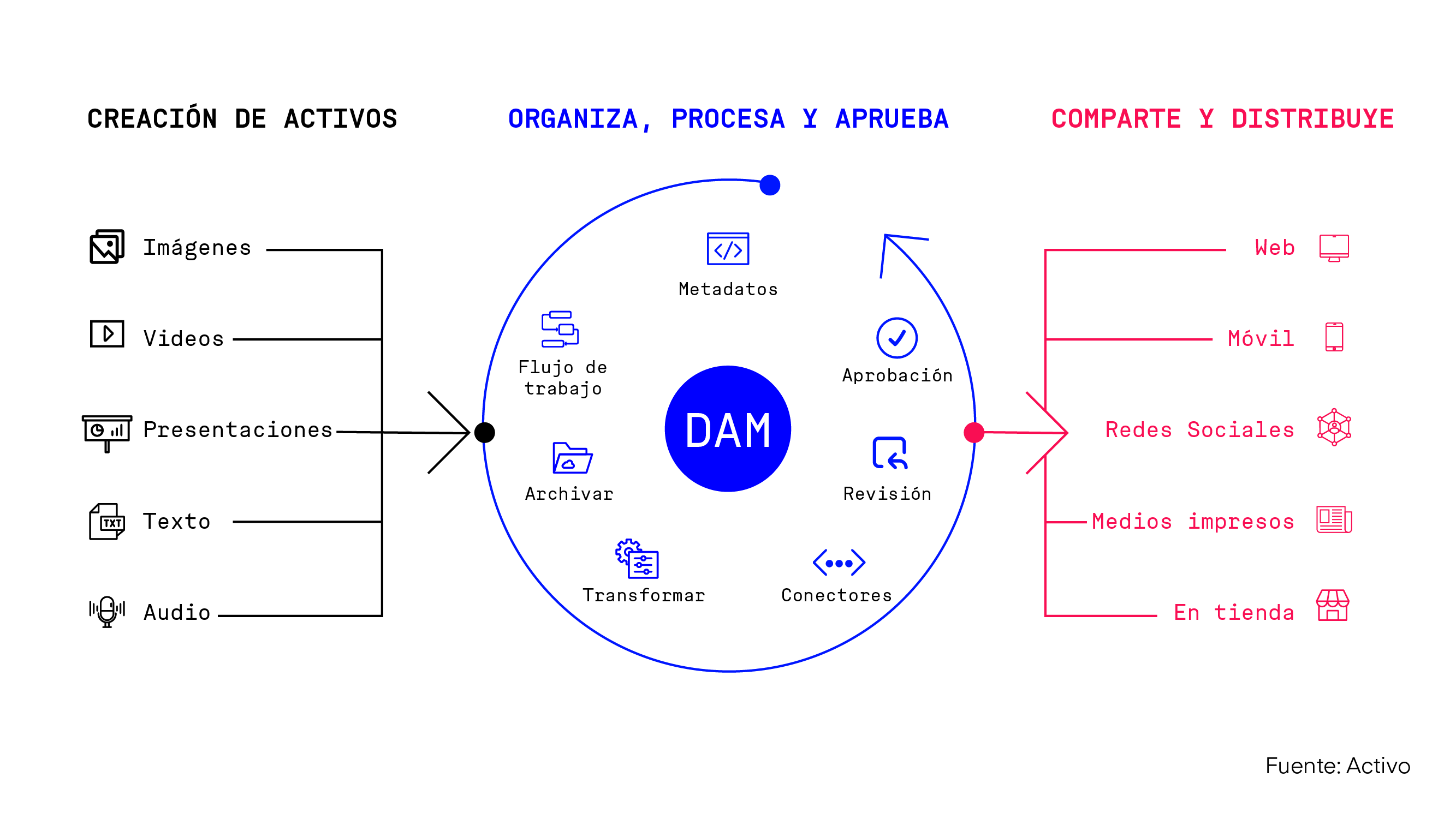DAM (Digital Asset Management): What it is and its advantages

A DAM (Digital Asset Management) is a software that helps businesses centralize, access, and distribute all their digital assets (images, videos, files), facilitating the search, retrieval, and reuse of these assets.
Are your company's images, videos and documents disorganized? Does it take hours to find a single file? Do colleagues edit presentations without following brand guidelines? Or are you concerned about third parties accessing confidential documents?
All of these problems can be solved through a DAM.
What is a DAM?
DAM stands for "Digital Asset Management. It is a software for managing, storing, organizing, and distributing digital assets, such as images, videos, audio, presentations, Excel files, PDFs, and other types of documents. A DAM allows businesses and organizations to have centralized access to their digital assets, making it easier to search, retrieve, and reuse them.
Some functions of a DAM system include:
Centralizing the storage and organization of digital assets in one place.
Searching for assets by keywords, categories, subcategories, metadata, and other search criteria.
Version control and access to assets, with defined user roles and permissions.
Integration with other systems, such as CMS or e-commerce platforms.
Workflow automation and approval processes.
Generation of reports and analytics on the use of digital assets.
Advantages of a DAM
Centralize all your digital assets such as images, videos, presentations, or files
A DAM provides a centralized place to organize and store digital assets such as images, videos, presentations, and documents. This makes it easier for employees to search for and access assets, avoiding the need to search for them in multiple locations or devices.
Avoid the use of old or outdated files.
Ensure that all your collaborators have access to the most recent version of digital files. This way, your team will not use documents or presentations with outdated information.
Save time and resources by automating asset management processes
A Digital Asset Management system automates many of the processes involved in managing digital assets. It reduces the time needed to perform tasks such as tagging, searching, and approving assets. This frees up employees from repetitive tasks so they can focus on other critical business tasks.
Enable collaboration among teams to manage multiple files
In addition, a DAM allows collaboration among teams and departments, making it easier to share assets and avoiding the need to duplicate work.
Protect your company's confidential files
A DAM allows administrators to control who can access assets and how they can be used. Security and access to your files become especially important when it comes to confidential or copyrighted assets.
Take care of and respect brand guidelines in all your digital assets
Maintain brand consistency by ensuring that all assets align with your company's brand identity and are used consistently across all channels.
Get key analytics on the use of your digital assets
A DAM provides information on how assets are being used, which can help organizations make informed decisions about which assets should continue to be used and which should be updated or retired.

The 4 Best DAM According to Forrester
Forrester is a research and consulting firm that helps companies make informed decisions about technology and marketing. It produces reports, analyses, and market forecasts based on in-depth research, data from its network of experts, and feedback from clients in various sectors.
Here are the top four DAM according to Forrester.
Aprimo
Aprimo offers a centralized source of truth for all brand assets, with the ability to handle a wide range of content types and use artificial intelligence for asset optimization and automated tagging and content descriptions. The platform also features collaboration and productivity tools, and is designed to support omnichannel experience delivery across a variety of channels and touchpoints.
Adobe Experience Manager Assets
Adobe Experience Manager Assets is a cloud-native digital asset management (DAM) platform that uses artificial intelligence and cloud scalability to deliver personalized content at scale. Additionally, the platform enables efficient collaboration between creatives and marketing professionals and has automation features for tasks such as tagging, cropping, and distributing content.
Widen
Widen allows you to quickly find images, videos, audio, and other creative files, as well as convert file formats on the fly. The platform offers features such as version management, rights management, and content analytics. It also has brand creation tools, permission management, auto-tagging, version control, and proofing tools. The platform is scalable and customizable and has a flexible API for integration with other systems.
Bynder
Bynder is a centralized solution for managing and distributing digital content. The platform offers a single source of truth for all digital assets, ensuring brand consistency and maximizing asset value. Platform features include file organization and search, access and usage rights control, asset optimization, and download in desired formats. The platform also integrates with other marketing technologies to create an interconnected digital ecosystem.


